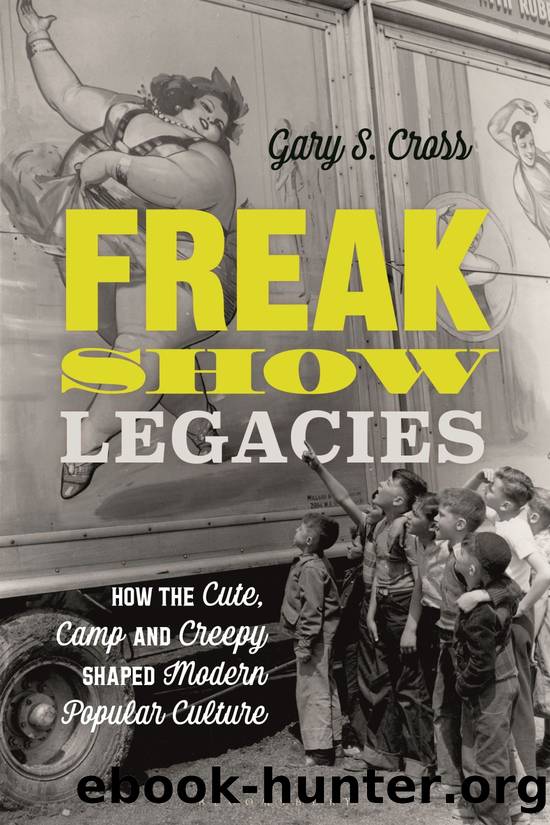Freak Show Legacies by Gary Cross

Author:Gary Cross
Language: eng
Format: epub
Publisher: Bloomsbury Publishing Plc
FIGURE 4.3 âLady Little, The Doll Lady,â c. 1911, at 9 years old, weighing 10.5 pounds, epitomizes the transition to the âcuteâ in her coy demeanor despite her formal dress. Postcard, authorâs collection.
Midgets reflected another closely related aesthetic trend: the âcute.â It can be defined as a look and behavioral pattern that adults associated with, even imposed, on children and found amusing, attractive, and especially endearing. The cute suggested dependency, vulnerability, and even ridiculousness at times. The cute evoked nostalgia or even a sense of timelessness. But the cute also meant the naively willful and sensuously desiring, even impish, spunky, and coquettish. These traits (more later), associated with children by 1900, were inevitably attached also to small people, often with another layer of irony and eeriness.
Elements of all this appear with Tom Thumb and other Barnumesque little people, but these flashes of cuteness were secondary to the older image and behavior of the miniature Victorian adult and child. The Burdett Twins (1881), a brother and sister act anticipated what was to come. These midget twins had been touring with circuses since they were thirteen. Their impish ways were emphasized in printed tales of the brotherâs hatred of school and his love of playing of tricks on his sister. Though by 1881, the sister, Fanny, had become âa fine womanâ and the brother a Major and âa man with a moustache,â they were still a great âsource of amusement to the little folksâ who crowded around the stage they performed on. As midget twins, they were not only perpetual children but appealed to children. 28
By the late 1880s, twin acts had become common in vaudeville. The image became ubiquitous when childlike twins had appeared regularly in product trademarks (e.g., Gold Dust Twins of black children for washing powder from 1892 and Campbell Kids for soup from 1905). All this was consistent with the fun-loving bad boy theme of American male childhoodâMark Twainâs Tom Sawyer and George Peckâs numerous stories of his youth as a âbad boy,â for example.29 The change, compared with the small people of Tom Thumbâs day, was subtle and gradual: while the Burdett Twins made no pretense to bourgeois aggrandizement, other midgets like Ike and Mike and Major Mite continued to be dressed formally in tuxedos, spats, top hat, and cane through the 1920s.30
But the trend was clear. Small people were becoming cuteified. Shortly after 1910, the best-known exemplars of this were the Doll family of midgets, who appeared on stage, in circus sideshows, and film (as in Freaks) through the 1950s. Born in Germany, Kurt Schneider (1902) and sister Grace (1898) played Hansel and Gretel in amusement parks in the 1910s; they were joined by their younger sisters, Daisy (b .1907) and Tiny (b. 1914) in the 1920s under the surname of their manager Burt Earles. After his death and when they toured with RBBB, they became the Doll Family, adopting a stage name appropriate for their appearance. One of many postcards of the siblings featured Grace dressed in exotic a Spanish gown and Daisy as a 1920s flapper dancing cheek to cheek with Harry.
Download
This site does not store any files on its server. We only index and link to content provided by other sites. Please contact the content providers to delete copyright contents if any and email us, we'll remove relevant links or contents immediately.
Aircraft Design of WWII: A Sketchbook by Lockheed Aircraft Corporation(31768)
The Great Music City by Andrea Baker(21197)
Call Me by Your Name by André Aciman(18955)
The Art of Boudoir Photography: How to Create Stunning Photographs of Women by Christa Meola(17834)
Shoot Sexy by Ryan Armbrust(17134)
Plagued by Fire by Paul Hendrickson(16632)
The Secret History by Donna Tartt(16611)
Portrait Mastery in Black & White: Learn the Signature Style of a Legendary Photographer by Tim Kelly(16479)
Adobe Camera Raw For Digital Photographers Only by Rob Sheppard(16381)
Photographically Speaking: A Deeper Look at Creating Stronger Images (Eva Spring's Library) by David duChemin(16153)
Bombshells: Glamour Girls of a Lifetime by Sullivan Steve(13102)
Pimp by Iceberg Slim(12924)
Ready Player One by Cline Ernest(12831)
The Goal (Off-Campus #4) by Elle Kennedy(12424)
Art Nude Photography Explained: How to Photograph and Understand Great Art Nude Images by Simon Walden(12340)
Kathy Andrews Collection by Kathy Andrews(10510)
Thirteen Reasons Why by Jay Asher(7783)
Wonder by R.J. Palacio(7725)
Goodbye, Things by Fumio Sasaki(7719)
